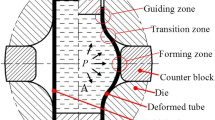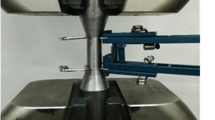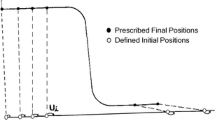Abstract
The present paper aims to introduce a new finite element approach in numerical modeling of the impact tube hydroforming process. For this purpose, the coupled Eulerian-Lagrangian method is used to replicate the formation of the water flow, resulting from an impact, leading to the fabrication of flawless T-shaped copper tubes. One major advantage of such coupled Fluid-Structure Interaction (FSI) modeling is that it eliminates the need for measuring the parameters associated with the process including the internal pressure, and works with the minimum number of inputs such as the impact velocity. Moreover, ductile damage analysis has been performed in FE studies to further investigate the damage evolution in specimens. Experimental tests are also carried out to examine the viability of performing the impact tube hydroforming process in low velocities and also to validate the authenticity of the presented numerical method. Results corroborate the accuracy of the presented numerical approach in predicting the process parameters, the final shape, and the onset and evolution of rupture in fabricated tubes. The feasibility of this approach shows promise in wide application for finite element modeling of the hydroforming process.















Similar content being viewed by others
References
Ahmetoglu M, Altan T (2000) Tube hydroforming: state-of-the-art and future trends. J Mater Process Technol 98(1):25–33
Ra JH, Han SW, VanTyne CJ, Moon YH (2019) Manufacturing of a wire-reinforced aluminum tube via hydroforming process. Int J Mach Tools Manuf 143:1–15
Cui XL, Yuan SJ (2019) Effects of superimposed hydrostatic pressure on bulging deformation and fracture of tubes in double-sided hydroforming. Arch Civil Mech Eng 19(2):569–583
Han S, Woo Y, Hwang T, Oh I, Moon YH (2019) Tailor layered tube hydroforming for fabricating tubular parts with dissimilar thickness. Int J Mach Tools Manuf 138:51–65
Lang L, Yuan S, Wang X, Wang ZR, Fu Z, Danckert J, Nielsen KB (2004) A study on numerical simulation of hydroforming of aluminum alloy tube. J Mater Process Technol 146(3):377–388
Beerwald C, Beerwald M, Dirksen U, Henselek A (2010) Impulse hydroforming method for very thin sheets from metallic or hybrid materials. In 4th International Conference on High Speed Forming, March 9th-10th 2010 Columbus, Ohio, USA. Institut für Umformtechnik-Technische Universität Dortmund
Golovashchenko SF, Gillard AJ, Mamutov AV (2013) Formability of dual phase steels in electrohydraulic forming. J Mater Process Technol 213(7):1191–1212
Ma Y, Xu Y, Zhang SH, Banabic D, Abd El-Aty A, Chen DY, …, Chen GQ (2018) Investigation on formability enhancement of 5A06 aluminium sheet by impact hydroforming. CIRP Ann 67(1):281–284
Clark DS, Wood DS (1950) The tensile impact properties of some metals and alloys. Trans ASM 42:45–74
Khodko O, Zaytsev V, Sukaylo V, Verezub N, Scicluna S (2015) Experimental and numerical investigation of processes that occur during high velocity hydroforming technologies: an example of tubular blank free bulging during hydrodynamic forming. J Manuf Process 20:304–313
Lang LL, Wang SH, Yang C (2013) Research on the innovative hybrid impact hydroforming. AIP Conf Proc 1567(1):1107–1110
Ali Tavoli M, Babaei H, Mohseni A, Rajabiehfard R (2016) Experimental and numerical forming of T shaped metallic tubes subjected to hydrodynamic loading. Modares Mech Eng 16(9):223–232
Alaswad A, Benyounis KY, Olabi AG (2012) Tube hydroforming process: a reference guide. Mater Design 33:328–339
Ahmed M, Hashmi MSJ (1998) Three dimensional finite element simulation of axisymmetric tube bulging. In Proceedings of the Pacific Congress on Manufacturing and Management, Brisbane, Australia (pp. 515–521)
Di Lorenzo R, Ingarao G, Chinesta F (2010) Integration of gradient based and response surface methods to develop a cascade optimisation strategy for Y-shaped tube hydroforming process design. Adv Eng Softw 41(2):336–348
Guo X, Liu Z, Wang H, Wang L, Ma F, Sun X, Tao J (2016) Hydroforming simulation and experiment of clad T-shapes. Int J Adv Manuf Technol 83(1):381–387
Williams BW, Worswick MJ, D’Amours G, Rahem A, Mayer R (2010) Influence of forming effects on the axial crush response of hydroformed aluminum alloy tubes. Int J Impact Eng 37(10):1008–1020
HaihuiZhu Z, He Y, Lin K, Zheng XF, Yuan S (2020) The development of a novel forming limit diagram under nonlinear loading paths in tube hydroforming. Int J Mech Sci 172:2411–2502
Bell C, Corney J, Zuelli N, Savings D (2020) A state of art review of hydroforming technology. IntJ Mater Form 13:789–828
Fiorentino A, Cretti E, Braga D, Marzi R (2010) Friction in asymmetric feeding tube hydroforming. IntJ Mater Form 3:275–278
Alitavoli M, Darvizeh A, Moghaddam M, Parghou P, Rajabiehfard R (2018) Numerical modeling based on coupled eulerian-lagrangian approach and experimental investigation of water jet spot welding process. Thin-Walled Struct 127:617–628
Mittal V, Chakraborty T, Matsagar V (2014) Dynamic analysis of liquid storage tank under blast using coupled Euler-Lagrange formulation. Thin-Walled Struct 84:91–111
Hsu CY, Liang CC, Teng TL, Nguyen AT (2013) A numerical study on high-speed water jet impact. Ocean Eng 72:98–106
Guilkey JE, Harman T, Xia A, Kashiwa B, McMurtry P (2003) An eulerian-lagrangian approach for large deformation fluid structure interaction problems, part 1: algorithm development. WIT Transactions on The Built Environment, p 71
Sadeghi H, Davey K, Darvizeh R, Rajabiehfard R, Darvizeh A (2020) An investigation into finite similitude for high-rate loading processes: advantages in comparison to dimensional analysis and its practical implementation. Int J Impact Eng 140:103554
Chizari M, Al-Hassani STS, Barrett LM (2008) Experimental and numerical study of water jet spot welding. J Mater Process Technol 198(1–3):213–219
Johnson GR, Cook WH (1985) Fracture characteristics of three metals subjected to various strains, strain rates, temperatures and pressures. Eng Fract Mech 21(1):31–48
Simulia DS, Fallis A, Techniques D (2013) ABAQUS documentation. Abaqus 6(53):1689–1699
Hassannejadasl A, Green DE, Altenhof WJ, Maris C, Mason M (2013) Numerical modeling of multi-stage tube hydropiercing. Mater Des 46:235–246
Author information
Authors and Affiliations
Corresponding author
Ethics declarations
Conflict of interest
Conflict of Interest for all authors - None.
Additional information
Publisher’s Note
Springer Nature remains neutral with regard to jurisdictional claims in published maps and institutional affiliations.
Rights and permissions
Springer Nature or its licensor (e.g. a society or other partner) holds exclusive rights to this article under a publishing agreement with the author(s) or other rightsholder(s); author self-archiving of the accepted manuscript version of this article is solely governed by the terms of such publishing agreement and applicable law.
About this article
Cite this article
Mohseni, A., Rezapour, J., Gohari Rad, S. et al. Low velocity impact tube hydroforming process: experiments and FSI modeling by considering ductile damage model. Int J Mater Form 16, 62 (2023). https://doi.org/10.1007/s12289-023-01783-y
Received:
Accepted:
Published:
DOI: https://doi.org/10.1007/s12289-023-01783-y




